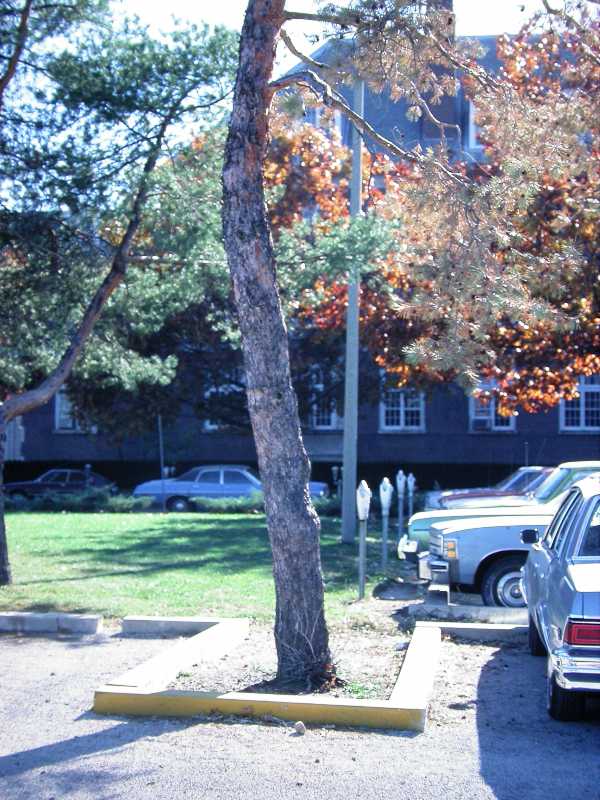 |
Site stress causing gradual decline of pine (Pinus) |
Decline of trees and shrubs can be described in two ways–gradual and sudden. Sudden decline can cause the death of a plant anywhere from a month to a couple of years. Gradual decline generally occurs over several years. It can sometimes be difficult to distinguish between the two, not noticing the decline until too late.
The sudden death of trees and shrubs can be brought on by a single, primary cause that kills an otherwise healthy plant. This might be the case with an aggressive pathogen like Dutch elm disease or white pine blister rust. With gradual decline, no one particular disease causes the plant to die. Instead, conditions weaken the plant to the point that secondary organisms are able to invade the stressed plant. Dieback and decline diseases are caused by the successive action of primary stress factor(s) followed by organisms of secondary action that can successfully attack only weakened trees. One may attribute the plant’s decline to these secondary organisms, but an experienced professional knows the problem lies deeper.
Factors that lead to decline are many. This includes adverse weather conditions, such as rapid changes in winter temperatures and late spring and early fall frosts, flooding or changes in the water table, drought, bark damage from lawn mower injury or weed eaters, frost cracks, or animal feeding. Injury can also occur from lawn weed killers or other chemicals, accumulated salt injury from road salt, environmental pollution, soil fertility, or girdled or restricted root development. Finally, leaf loss from insects or diseases and damage from construction around the tree because of soil fill, root pruning, or soil compaction from heavy equipment can also be causes. Working singly or together over several years, these stresses can eventually result in tree or shrub death. A good example leading to gradual decline might be root decline where symptoms observed in the aboveground parts of the plant usually begin in the root system. When trees and shrubs are under stress, physiological changes occur in the roots, allowing fungi to infect the tissue.
Removal of the stress factors is required to save the declining plant. In many cases, action may come too late or may be impractical to carry out.
Symptoms and Diagnosis
Symptoms usually develop slowly and may not be noticed immediately. Trees and shrubs exhibit an overall loss of vigor. Early symptoms might include premature fall coloration of leaves, late leaf emergence in spring, production of foliage in clumps, decrease in twig growth, dieback, death of tissues between the leaf veins, and premature leaf drop. Later symptoms might include sprouting from the trunk, heavy seed crop production, dieback of larger limbs and branches, and foliage noticeably smaller and lighter green (chlorotic). The foliage over the entire plant may also look thinner in decline conditions. These visible symptoms may not occur until the plant is severely stressed. In the autumn, clusters of mushrooms may form at the base of infected trees.
Wood-boring insects such as borers are also frequently associated with declining plants as they are attracted to weakened, stressed plants. Scale insects are also commonly found on stressed plants.
Integrated Pest Management Strategies
1. Location.Avoid placing plants in a stressful situation. Select species that are suited to the conditions of the planting location or modify the planting site to suit the requirements of the plant. This would include planting in a well-draining soil with the correct pH for the plant. Environmental conditions should also be considered, such as full sun for a sun-loving plant—not in the shade of another plant. Use warm weather plants in warm climates and moisture-loving plants in wet conditions.
2.Inspection. Prevention and early detection are the key to keeping trees and shrubs healthy. Inspect plants often and watch for symptoms of stress.
3. Planting. Do not crowd plants in restricted areas, such as close to sidewalks or streets, or place too many plants in an area that cannot support them.
4. On-going care. Water to reduce drought stress. Using a fertilizer like 5-10-5 that is high in phosphorus and low in nitrogen will stimulate root growth rather than shoot growth. Mulching over the root system will help prevent the loss of water, decrease compaction from rain, and keep the roots cool in the summer and warmer in the winter.
5. Pruning. Prune all dead and dying branches and no more than 10 to 20% of the remaining live branches at any one time. This should balance the foliage to the root system. If more pruning is necessary, complete this over 2–3 years.
6. Compaction. Compacted soil will cause a slow, sure death for many plants. Locate children’s play areas, dog runs, or car parking areas away from valuable trees and plantings. Core aerate compacted areas and around the drip line of trees. Change traffic patterns to reduce compacting the soil under trees.
7. Removal.Remove dead trees and shrubs and dispose of any infected material.
Organic Strategies
Strategies 1, 2, 4, 5, and 6 are strictly organic approaches. Using an appropriate organic fertilizer would be a viable organic approach to Strategy 3.
More images:
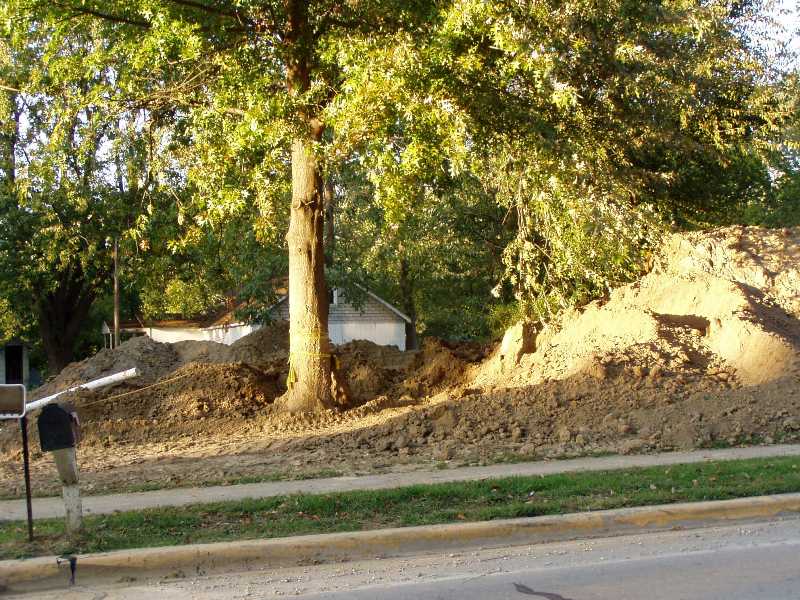 |
| Construction injury to oak (Quercus) |
|
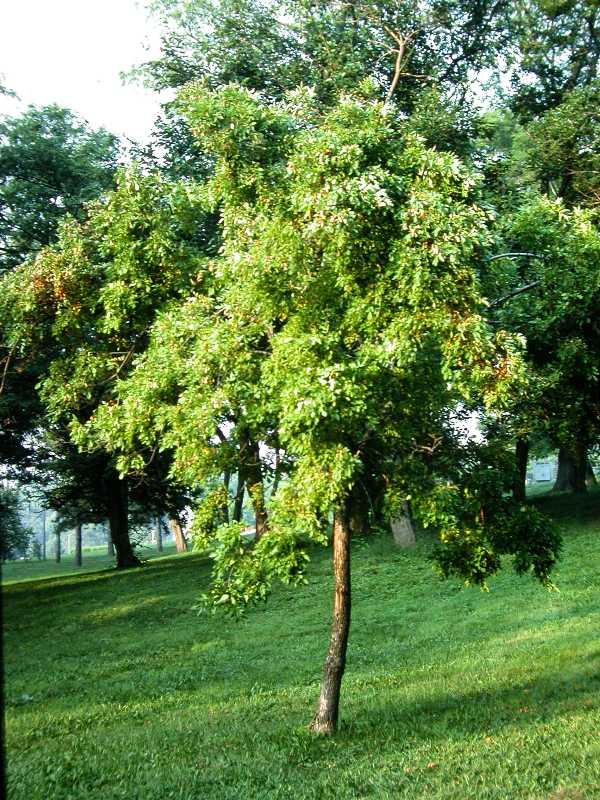 |
| Distorted trunk and stunting of ash (Fraxinus) due to mechanical damage |
|
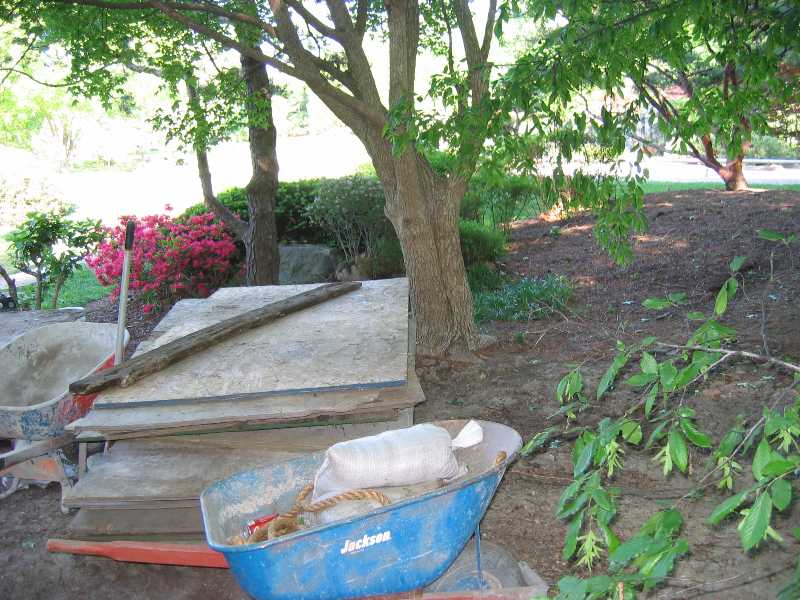 |
| Placing heavy items in the root zone of a tree or shrub --here a maple (Acer) -- compacts the soil and can lead to root injury, decline and even death of the entire tree. |
|
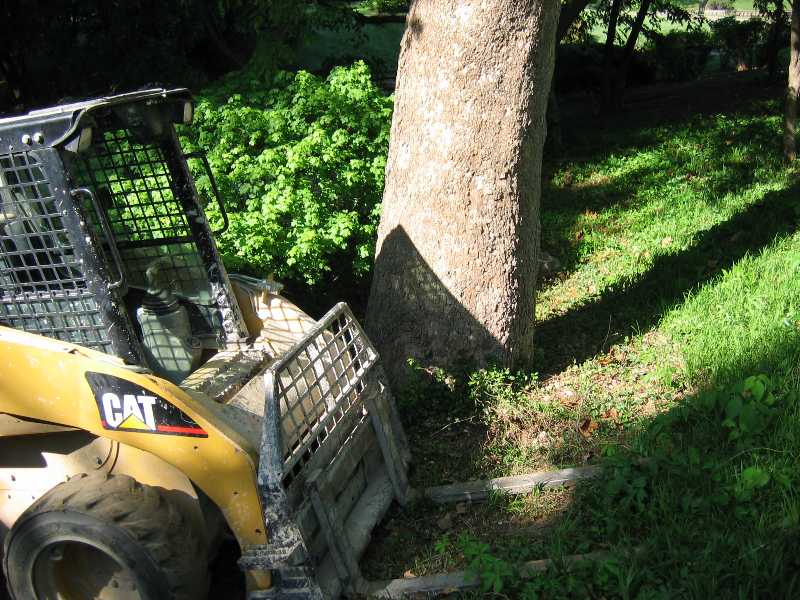 |
| Heavy equipment compacts the soil. Placed in the root zone of a tree, it can injure tree roots, leading to decline and even death of the tree. |
|